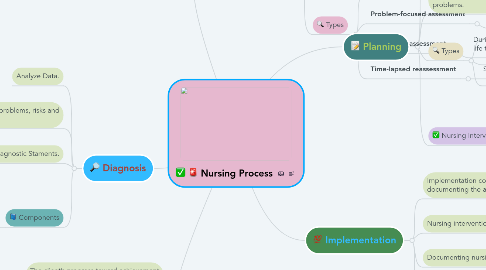
1. Assessment
1.1. The systematic and continuous collection
1.1.1. Contributions
1.1.1.1. Gather information about the patients condition.
1.2. Organization
1.3. Validation
1.4. Documentation of data
1.5. Types
1.5.1. Initial nursing assessment
1.5.1.1. Performed within specified time after admission.
1.5.2. Problem-focused assessment
1.5.2.1. To determine the status of a specific problem identified in an earlier assessment.
1.5.3. Emergency assessment
1.5.3.1. During emergency situation to identify any life threatening situation.
1.5.4. Time-lapsed reassessment
1.5.4.1. Several months after initial assessment.
2. Diagnosis
2.1. Analyze Data.
2.2. Identify health, problems, risks and strenghts.
2.2.1. Contributions
2.2.1.1. According De La Cuesta (1983), is clinical judgment concerning a human response to health conditions/life processes, or a vulnerability for that response, by an individual, family, group, or community.
2.3. Formulate diagnostic Staments.
2.4. Components
2.4.1. The problem and its definition
2.4.1.1. The problem statement describes the client’s health problem.
2.4.2. The etiology
2.4.2.1. The etiology component of a nursing diagnosis identifies causes of the health problem.
2.4.3. The defining characteristics
2.4.3.1. Defining characteristics are the cluster of signs and symptoms that indicate the presence of health problem.
3. Evaluation
3.1. The client’s progress toward achievement of goals/outcomes
3.2. The effectiveness of the nursing care plan.
3.2.1. Contributions
3.2.1.1. Once all nursing intervention actions have taken place, the nurse completes an evaluation to determine the goals for patient wellness have been met.
3.3. Components
3.3.1. Comparing the data with desired outcomes.
3.3.2. Continuing, modifying, or terminating the nursing care plan.
4. Planning
4.1. Involves decision making and problem solving.
4.2. It is the process of formulating client goals.
4.2.1. Contributions
4.2.1.1. Once a patient and nurse agree on the diagnoses, a plan of action can be developed.
4.3. Nursing interventions required to prevent, reduce, or eliminate the client’s health problems.
4.4. Types
4.4.1. Initial Planning
4.4.1.1. Planning which is done after the initial assessment.
4.4.2. Ongoing Planning
4.4.2.1. It is a continuous planning.
4.4.3. Discharge Planning
4.4.3.1. Planning for needs after discharge.
4.5. Nursing Interventions
4.5.1. Independent interventions
4.5.1.1. Activities that nurses are licensed to initiate on the basis of their knowledge and skills.
4.5.2. Dependent interventions
4.5.2.1. Activities carried out under the orders or supervision of a licensed physician.
4.5.3. Collaborative interventions
4.5.3.1. Actions the nurse carries out in collaboration with other health team members.
5. Implementation
5.1. Implementation consists of doing and documenting the activities.
5.2. Nursing interventions.
5.2.1. Contributions
5.2.1.1. The implementing phase is where the nurse follows through on the decided plan of action, which is specific to each patient and focuses on achievable outcomes.
5.3. Documenting nursing activities.
5.4. Components
5.4.1. Implementing the nursing interventions.
5.4.2. Documenting nursing activities.
